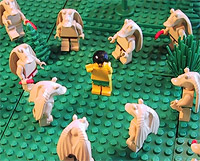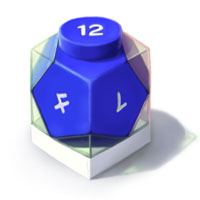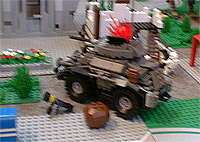| 4: The Player Turn |
|
|
 |
Sprinting |
|
 |
Quick Actions |
|
|
|
 |
Use Ratings |
|
 |
Extended Actions |
|
 |
Large Actions |
|
|
|
 |
Cone of Vision |
|
 |
Who Acts First |
|
 |
Bailing |
|
|

| The
BrikThulhian Troika can be thought to represent the cycle
of Movement, Action, and Enemy Response. But on the other
hand it can really be thought to represent just about
anything. |
| Mike
Rayhawk, 2005 |
|
Chapter Four: The Player Turn
 |
| “The art of war is simple
enough. Find out where your enemy is. Get at
him as soon as you can. Strike him as hard as
you can, and keep moving.” |
| - Ulysses S. Grant |
|
|
 |
During a player’s turn, each of his units may engage in whatever
Movement is allowed by its Move statistic, and may each
take one Action (preferably an attack). In the meantime,
enemy units with unused Actions to spend have the option to take
them in Enemy Response to his behavior.
 |
| “Even if you're on the right
track, you'll get run over if you just sit there..” |
| - Will Rogers |
|
|
 |
 During
Movement, a minifig's Move rating of 5" allows him to
move five inches in any direction - he can run across five inches
of level ground, climb five inches’ worth of stairs or ladders,
or leap over five inches of chasm. During
Movement, a minifig's Move rating of 5" allows him to
move five inches in any direction - he can run across five inches
of level ground, climb five inches’ worth of stairs or ladders,
or leap over five inches of chasm.
His movement is limited in a couple of ways. He can’t move through
obstacles, or leap higher than 1” (three bricks) in a single
jump. For difficult types of movement requiring both arms (e.g., swimming,
crawling, or climbing a rope or cliff), the Move cost is doubled (every
inch traveled costs two inches of Move), and the minifig cannot make
attacks while his arms are occupied.
If the minifig moves within striking distance of an enemy’s hand
weapon, it's assumed that the enemy unit automatically attacks him,
unless the opposing player says otherwise. If the minifig decides
to Counter the attack, they are both entered into Close Combat (5.2:
Close Combat) and the minifig’s Movement is over for
the turn. If not, the minifig may continue moving normally, assuming
he survives the attack.

| Unarmed, naked, and
surrounded by sausage-wielding Dungans, this minifig's
best option is to Sprint like hell and never look back. |
"Ghoirboy,"
2002
Photo: Shaun Sullivan
Winner: Suzanne Rich |
|
Sprinting
 |
| “One ought never to turn
one's back on a threatened danger and try to run
away from it. If you do that, you will double the
danger. But if you meet it promptly and without
flinching, you will reduce the danger by half. Never
run away from anything. Never!” |
| - Winston Churchill |
|
|
 |
When speed is critical, a minifig (or any living unit) can Sprint,
giving itself 1d6 extra inches of Move for the turn, as long as the minifig's entire Movement for the turn (including the Sprint) is in a straight line. Sprinting may be combined with a Charge attack as a
single Action (5.4: Charge!);
otherwise, Sprinting uses the unit's Action for the turn, and it can
make no other attacks.
Quick Actions
Although a minifig is limited to one major Action for the turn, there
are many lesser actions he can perform that are too minor to count
against this limit. Actions that require no particular attention,
aiming, or dice rolls count as Quick Actions, and are taken
as a part of regular Movement. Very simple acts, like picking up or
dropping regular equipment objects, holding a conversation, or sneezing,
incur no penalty. More involved actions, such as picking up a heavy
object (up to the size of a 2x4 brick), opening a door, or holstering
a weapon, cost 1” of Move – taking that action took a small
amount of time, and now the minifig has less time for moving.
| Common Quick Actions |
Cost |
| Talking |
(no cost) |
| Opening or closing a door |
-1" |
| Picking up or dropping equipment items |
(no cost) |
| Picking up a heavy item |
-1" |
| Dropping to a seated, kneeling, or
prone position |
(no cost) |
| Standing up from a seated or kneeling
position |
-1" |
| Standing up from a prone position |
-2" |
|
 |
| “Action speaks louder than
words, but not nearly as often.” |
| - Mark Twain |
|
|
 |
 Any
act that requires a minifig’s attention, focus, or concentrated
effort is an Action. Due to limits on time and minifig brainpower,
he may only take one such Action per turn. He may use his single Action
before, after, or in the middle of his Movement, but he only gets
one, so he must spend it wisely. Any
act that requires a minifig’s attention, focus, or concentrated
effort is an Action. Due to limits on time and minifig brainpower,
he may only take one such Action per turn. He may use his single Action
before, after, or in the middle of his Movement, but he only gets
one, so he must spend it wisely.
A minifig will almost always use his Action to make an Attack (5.1:
Making Attacks). But even the most belligerent minifigs
will concede that less direct types of Actions are sometimes called
for.
Use Ratings
Actions are rarely automatic successes, since minifigs are clumsy
and easily distracted. Actions are given a Use rating describing
their relative difficulty. The minifig attempting the Action must
make a Skill Roll to see if his attempt succeeds. If his Skill
Roll is equal to or higher than the Use rating, the Action succeeds.
If it is lower, the Action fails, and the minifig suffers whatever
consequences would logically result.
Minifigs make attacks using the Use rating of their equipped weapon
(Chapter 3: Minifig Weapons).
Besides attacks, there are all kinds of unusual tasks that minifigs
might attempt, from the trivial to the impossible. Most will have
a default Use rating of 3; players may agree on a higher or lower
difficulty as seems appropriate.

| Dice-worshipping Dodekube
cultists believe that logic is an illusion and that all
of reality is nothing more than the cosmic dice rolls
of disinterested Human gods. Their belief arises from
the fact that even the most sober minifigs have sometimes
been able to "see the dice." |
|
| Use: |
Difficulty |
Attack Example |
Other Examples |
| - |
trivial (no roll required) |
kicking a minifig
corpse |
putting pants on;
stacking bricks |
| 2 |
easy; almost
always succeeds |
striking someone with
a stick |
jumping off a ledge
to grab a rope;
hacking a Diebold election machine |
| 3 |
normal; might take
more than one try |
slashing someone with
a scimitar |
kicking open a regular
locked door;
mixing complex drinks |
| 4 |
tricky; even
odds of success |
hacking someone with a halberd |
rock-climbing a vertical
cliff face;
reassembling an unfamiliar rifle |
| 5 |
difficult |
bashing someone with
a battering ram |
disarming a bomb;
winning at Vegas |
| 6 |
very difficult |
striking a minifig
with the
energy sword of a giant mech |
walking a tightrope;
performing minor surgery |
| 8 |
heroic |
precision-mashing
a minfig with
a boulder fired from a catapult |
Olympic-level gymnastics;
catching a crossbow
bolt in flight |
| 10 |
legendary |
sniping a minifig from an offshore artillery battery |
hacking into a military satellite;
dodging concentrated machine-gun fire |
| 12 |
godlike |
bullseyeing a minifig
with a laser
blast from an orbital satellite |
injuring a Human;
performing a judo throw on a T-rex |
|
Extended Actions
 |
| “Victory belongs to the
most persevering.” |
| - Napoleon Bonaparte |
|
|
 |
The opposite of Quick Actions, some actions are so involved or time-consuming
that they take up a minifig’s entire turn, even if they aren’t
difficult enough to require a Skill Roll. These are called Extended
Actions. Examples include piloting a vehicle, operating a computer,
putting on a suit of plate mail, rowing a rowboat, or reading a wargame
rulebook. Extended Actions use up the minifig’s entire Movement
and Action; he may do nothing else during that turn.
The most common Extended Action for minifigs, often extending over
a very large number of turns, is "Being Dead."
Large Actions
 |
| “Great acts are made up
of small deeds.” |
| - Lao Tzu |
|
|
 |
Most actions involve objects designed to be handled or operated by
a single minifig - swords, doors, machine gun turrets, or toilets,
for example. Other objects may be put to unconventional uses by a
minifig if the objects are small enough - generally, equipment items
or anything one inch or smaller in Size (7.1:
Structure: Size). Lifting a larger object (automobiles,
portcullises, boulders) or operating a device not designed for single-minifig
use (naval vessels, battering rams, giant-sized doors) is a Large
Action and either requires multiple minifigs working together,
or, in some cases, one minifig working over the course of multiple
turns. As a rule of thumb, the number of minifigs required (or turns
required for a single minifig) to perform a Large Action is equal
to the Size in inches of the object being used. Players may argue
that a specific Large Action requires more or fewer minifigs than
simple Size would dictate, depending on the situation. Be prepared
to make a quick What I Say Goes roll.
For the purpose of Large Actions, larger units (Chapter 7: Special
Creations) are worth a number of minifigs equal to their own Size, if the Large Action is a matter of strength. A triceratops
would be equivalent to several minifigs when knocking over a siege
tower, hauling lumber, or righting an upended tractor, for instance,
but would not particularly handy for the Large Actions of manning battleship
stations or playing symphonies.
 |
| “Opportunities multiply
as they are seized.” |
| - Sun Tzu |
|
|
 |
 If
you don't use a unit's Action on your own turn, you can save it to
use in response to opponents' actions - shooting at scouts as they
pop out from behind cover, whacking soldiers that wander into range
of your melee weapon, or pressing the self-destruct button when all
the invitees have boarded the cruise liner for your birthday party.
Of course, your enemies are free to use their saved Actions during
your turn as well, so tread carefully! If
you don't use a unit's Action on your own turn, you can save it to
use in response to opponents' actions - shooting at scouts as they
pop out from behind cover, whacking soldiers that wander into range
of your melee weapon, or pressing the self-destruct button when all
the invitees have boarded the cruise liner for your birthday party.
Of course, your enemies are free to use their saved Actions during
your turn as well, so tread carefully!
To make a Response Action, a unit must not have used its Action
on its previous turn. Similar to the Angry Inch of a Close Combat
attack (5.2: Close Combat),
Responding units may move up to one inch in order to press, grab,
or otherwise touch a critical object (pulling a lever or slamming
a door, for instance), or in the usual manner as part of a Close Combat
attack. Otherwise, the unit must already be in position to act.
Cone of Vision
A Responding unit must be aware of the specific enemy action or movement
to which he's reacting, and in a timely enough fashion to make a proper
Response. In almost all cases, this means he has to be able to see
it. If he sees an enemy soldier raise a rifle and take aim, he may
have time to dive for cover; if all he knows is that he heard a gunshot,
it's way too late.
A minifig's Cone of Vision points in whichever direction his
head is facing, and forty-five degrees to either side, making a complete
cone of ninety degrees. If an object or event is within that field
of view, the minifig can see it; if not, he can't. Whenever it's hard
to tell whether or not an object falls within that cone, a quick What
I Say Goes roll will resolve the issue neatly.
Who Acts First

| The results of
this roll have clearly gone better for Shaun than
for Wayne. |
| Photo: Alfred
Speredelozzi |
|
 |
| "Things may
come to those who wait, but only the things
left by those who hustle.” |
| - Abraham
Lincoln |
|
|
 |
Even if a minifig can see disaster about to strike, he won't
always be fast enough to respond in time.
If a unit is taking an Action in Response to enemy Movement,
such as firing at the first person to walk past an open window
or diving out of the way of a rolling boulder, then his Response
is automatically fast enough; take the Action as normal. If
his Action is in Response to an enemy Action, even if one or
both of those Actions are Quick Actions, then a contest of Skill
determines who acts fastest.
The enemy unit makes his Skill Roll and subtracts the Use rating
for the Action he is attempting (if it has one); the Responding
unit rolls his own Skill and subtracts the Use rating (if any)
of his Response. The unit with the higher total acts first,
even if their total was less than zero (meaning their Action
was a failure). In the case of a tie, assume that both Actions
occurred simultaneously if possible; otherwise, the player whose
turn it is acts first.
 |
| Example: Two gunfighters
meet outside the saloon for a duel at high
noon. They eye each other warily, each prepared
to draw and fire the moment their opponent
so much as twitches. On Hairtrigger Wayne's
turn, he decides he's going to fire first,
and declares his attack on Shoot-Em-in-the-Back
Shaun. Shaun declares a similar attack on
Wayne as a Response Action. Both players roll
their Skill of 1d6 against their pistols'
Use rating of 3. No doubt due to heavy drinking,
Wayne rolls a 2 and Shaun rolls a 1; both
miss their shots. After subtracting their
Use ratings, Wayne's total of -1 is higher
than Shaun's total of -2; his missed shot
occurs first. Shaun's shot occurs second,
and since it was a Critical Failure, the gun
goes off before he even gets it out of the
holster. Shaun collapses in agony after shooting
himself in the foot, and a great cheer goes
up as the crowd of spectators mistakenly assumes
that Wayne's shot hit its mark. |
|
|
 |
|
Bailing

| When a rooftop ninja
tosses grenades into his turret hatch, this tank commander
decides that discretion is the better part of valor, and
Bailing the hell Out is the better part of not getting
his butt obliterated. |
Photo: Eric Kingsley
NELUG's "April Fools War" April 2000 |
|
While the recommended Response to almost any enemy behavior is to
attack with everything you've got, there are times when a unit's best
bet is to make a desperate leap for safety. He may be dodging an oncoming
truck, jumping out of a helicopter that's about to be hit by missiles,
or diving behind cover when a machine gun turret opens fire on him.
Units are not able to Sprint as a Response Action. Instead, assuming
their movement type would logically allow it, they have the option
to Bail. A Bailing unit can dive to any spot within 1d6"
of its current position, ending up lying on the ground in a prone
position. After Bailing, a unit is Disrupted, meaning he may
not attempt any further action until his next turn, not even to Counter
a Close Combat attack. On its following turn, the unit recovers (spending 2" of Move to stand up again) and
may once again behave as normal.
There is no Use rating for Bailing, so a Bailing unit will get to
act first more often than not. However, because he has to roll 1d6
to see how far he's allowed to jump, a low roll can sometimes mean
that he doesn't Bail far enough, and a Critical Failure means he just
falls on his face right where he's standing. If a Bailing unit doesn't
jump far enough to escape the path of an oncoming train, he still
gets hit by the train; if he's Bailing to avoid a rifle volley and
doesn't quite reach cover, the riflemen just fire at him in his new
position instead of his old one.
|
|